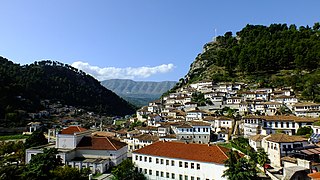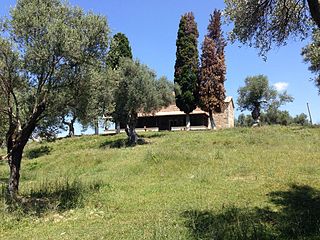This is a list of lists of historical and living Albanians who are famous or notable, sorted by occupation and alphabetically.

Berat is the ninth most populous city of Albania and the seat of Berat County and Berat Municipality. By air, it is 71 kilometres north of Gjirokastër, 70 kilometres west of Korçë, 70 kilometres south of Tirana, and 33 kilometres east of Fier.

Berat County, officially the County of Berat, is a county in the Southern Region of the Republic of Albania. It is the ninth largest by area and the ninth most populous of the twelve counties, with around 140,956 people within an area of 1,798 km2 (694 sq mi). The county borders the counties of Elbasan to the north, Korçë to the east, Gjirokastër to the south and Fier to the west. It is divided into five municipalities, Berat, Dimal, Kuçovë, Poliçan and Skrapar, with all of whom incorporate twenty-five administrative units.

Onufri, Onouphrios of Neokastro or Onouphrios Argytes, was a 16th century Archpriest of Elbasan and the most important painter of Orthodox murals and icons in the early post-Byzantine era in Albania. He founded a school of painting in Berat and extended his influence as far afield as Kastoria. Trained in Venice, he infused Albanian icon painting with the artistic climate of the Italian Renaissance. His works reveal a great degree of originality and ecclesiastically combined post-Byzantine and Gothic elements. Onufri's works played a decisive role in the following trends of Albanian art, up to the 19th century.

Albanian art refers to all artistic expressions and artworks in Albania or produced by Albanians. The country's art is either work of arts produced by its people and influenced by its culture and traditions. It has preserved its original elements and traditions despite its long and eventful history around the time when Albania was populated to Illyrians and Ancient Greeks and subsequently conquered by Romans, Byzantines, Venetians and Ottomans.

The Monastery of the Nativity of the Theotokos in Ardenica (Albanian: Manastiri Lindja e Hyjlindëses Mari,; or simply Ardenica Monastery is an Eastern Orthodox monastery, located 18 kilometers south of Lushnjë, Albania, along the national road that links Lushnjë to Fier.

The National History Museum is a historical museum in Tirana, Albania. It was opened on 28 October 1981 and is 27,000 square metres in size, while 18,000 square metres are available for expositions.

David Selenica, also commonly known as Selenicasi, was an Albanian Orthodox icon and fresco painter of the Post-Byzantine period in the seventeenth century. Alongside Onufri and Kostandin Shpataraku, he is regarded as one of the most prominent figures of medieval Albanian art.
The brothers Kostandin Zografi and Athanas Zografi were Albanian painters of the 18th century from Dardhë, in modern Korçë municipality, southern Albania. They are regarded as the most prominent painters of the Albanian post-Byzantine icon art of the 18th century and generally of the region of Epirus. Along with David Selenica, Kostandin Shpataraku, Terpo Zografi, Efthim Zografi, Joan Çetiri, Naum Çetiri, Gjergj Çetiri, Nikolla Çetiri, and Ndin Çetiri they represent the School of Korçë painting.

The National Museum of Medieval Art is a national museum dedicated to medieval art and history in Korçë, Albania. The museum is located on Fan Noli Boulevard in the south-east of the city of Korçë. It was established on April 24, 1980, and the building was reconstructed on October 4, 2016, with the cooperation of the city municipality and the Greek Government fund.

The St. Mary of Blachernae Church is a Byzantine church in Berat, Albania. It is named after the famous Church of St. Mary of Blachernae, near the Palace of Blachernae in Constantinople. It is believed that the church was built on the foundations of a ruined 5th century church that existed at the same place. The church is regarded as one of Berat's most important historical and architectural monuments and is a key tourist attraction for both Berat and Albania.

Saint Jovan Vladimir's Church is a church in Shijon, Elbasan County, Albania. It is dedicated to the Dukljan prince and saint Jovan Vladimir, the son-in-law of the Bulgarian Tsar Samuil. It became a Cultural Monument of Albania in 1948. The first temple is the oldest large Orthodox basilica from the times of Tsar Samuil, rebuilt as present church by the Thopia family in 1381. During the 18th century Kostandin Shpataraku painted the walls of the church.

St. Paraskevi's Church is a church in Çetë, Kavajë Municipality, Albania. It became a Cultural Monument of Albania in 1963.

Kostandin Shpataraku, also commonly known as Shpataraku, was an Albanian Orthodox icon and fresco painter of the Post-Byzantine period in the eighteenth century. He continued to combine Byzantine tradition with influences from the Renaissance. He is regarded as one of the most prominent figures of medieval Albanian art besides Onufri and David Selenica.

Onouphrios is a transliteration of the Greek Ονούφριος, originally from an Egyptian name, Christian name borne by Orthodox and Catholic Saints and notable people and may refer to:
Constantine of Berat, known among Albanians as Kostandin Jermonak Berati or shortly Kostë Berati, was an Albanian writer and translator of the 18th century.
Painter Dimitrije Daskal was the founder and head of the Dimitrijević-Rafailović family of painters whose ten members, from the seventeenth to the second half of the nineteenth century, worked icons and murals on the southern coast of Montenegro and southern Bosnia and Herzegovina.
Saint Nicholas's Church is a cultural heritage monument in Kurjan, Fier County, Albania.

The 20 churches of Berat Castle are Eastern Orthodox churches built inside the Berat Castle. They consist of frescoes and iconostasis painted by famous Albanian icon painters such as Onufri, Kostandin Shpataraku, Zografi Brothers and more.




















